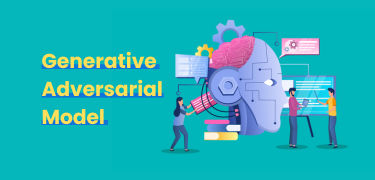Generative Adversarial Network (GAN)
Generative adversarial networks (GANs) are a type of machine learning model that can be used to generate new data that is similar to the data it was trained on. GANs have been used to generate realistic images, videos, and text.


Generative Adversarial Model: Introduction
Generative adversarial networks (GANs) are a type of machine learning model that can be used to generate new data that is similar to the data it was trained on. GANs have been used to generate realistic images, videos, and text.
In augmented reality (AR), GANs can be used to generate virtual objects and environments that are indistinguishable from real objects which helps in visual and graphic design. This can be used to create more immersive and engaging AR experiences.
Components of Generative Adversarial Networks (GANs)
Generator: The generator is a neural network that takes random noise as input and generates synthetic data (e.g., images, text, audio) that mimics the distribution of the training data.
Discriminator: The discriminator is another neural network that evaluates the authenticity of the generated data. It learns to distinguish between real and fake data.
How GAN Model work in A0052
GAN model work by pitting two neural networks against each other. The first neural network, called the generator, creates new data. The second neural network, known as the discriminator, checks whether the data is real or fake. The generator is trained on a dataset of real data.
The discriminator is also trained on the same dataset, but it is also given some fake data that was generated by the generator. The generator and discriminator are trained iteratively. In each iteration, the generator tries to create new data that is more realistic. The discriminator tries to become better at distinguishing between real and fake data.
Over time, the generator creates better realistic data, and the discriminator becomes better at distinguishing between real and fake data.
Applications of GANs in AR
GANs can be used for a variety of applications in AR, including:
Generating virtual objects: GAN model can be used to generate virtual objects that are indistinguishable from real objects. This can be used to create more immersive AR experiences, such as placing a virtual coffee cup on a real table.
Generating virtual environments: GANs can generate virtual environments that are indistinguishable from real ones. This can create AR experiences, allowing users to explore places like the Grand Canyon or the Eiffel Tower.
Image translation: GANs can be used to translate images from one domain to another. For example, a GAN could be used to translate a photo of a cat into a photo of a dog.
Style transfer: GANs can be used to transfer one image's style to another. For example, a GAN could be used to transfer the style of a Van Gogh painting to a photo of a landscape.
Future of GANs in AR
Despite the challenges, GANs have the potential to revolutionise AR. GANs can generate more realistic and immersive AR experiences as they become more powerful and efficient. This will open up new possibilities for AR applications in various fields, such as education, entertainment, and healthcare.
Tips for training a Generative Adversarial Network (GAN)
- Use a Stable Optimizer: Use the Adam optimizer or another stable optimizer to train your GAN. GANs are notorious for being difficult to train, and using a stable optimizer can help mitigate this issue.
- Use Batch Normalization: Batch normalization can help stabilize training by normalizing the inputs to each layer.
- Implement Feature Matching: Feature matching involves matching the statistics of the features extracted by a pretrained network between the real and generated samples. This can help improve the quality of the generated samples.
- Monitor Losses: Keep a close eye on both the generator and discriminator losses during training. A common problem is one component overpowering the other, leading to poor results.
- Use Gradient Penalties: Techniques like Wasserstein GAN with Gradient Penalty (WGAN-GP) can help stabilize training by penalizing the norm of the gradient of the critic with respect to its input.
- Use Label Smoothing: Instead of using hard labels (0 and 1) for real and fake samples, use smoothed labels (e.g., 0.9 for real and 0.1 for fake) to reduce model sensitivity to small changes.
- Regularize Discriminator Updates: To prevent the discriminator from overpowering the generator, you can limit the number of updates it receives per generator update (e.g., using the "discriminator update rate" technique).
- Generate Diverse Samples: To encourage the generator to produce diverse samples, you can use techniques like minibatch discrimination or add noise to the input.
Generative Adversarial Networks Use Cases
- Image Generation: Generative Adversarial Networks (GANs) are widely used for generating realistic images. They can create high-quality, photorealistic images of objects, scenes, and even people, which can be used in various applications such as art, design, and entertainment.
- Data Augmentation: GANs can be used to augment training data for machine learning models. By generating new, synthetic data that is similar to the original dataset, GANs can help improve the performance and robustness of machine learning models, especially in cases where the original dataset is limited or biased.
- Image-to-Image Translation: GANs can be used for image-to-image translation tasks, such as converting images from one domain to another. For example, they can be used to convert satellite images to maps, or to translate sketches into photorealistic images.
- Super-Resolution: GANs can also be used for image super-resolution, where low-resolution images are converted into high-resolution images. This can be useful in applications such as enhancing the quality of medical images or improving the resolution of surveillance footage.
- Anomaly Detection: GANs can be used for anomaly detection in images or data. By training a GAN on normal data, it can learn to generate data that is similar to the normal data distribution. When presented with new data, the GAN can be used to detect anomalies that deviate significantly from the learned distribution.
Conclusion
Want to know more about AR technology applications? Join us at Seamedu School of Pro-Expressionism for a 3-year degree in Game Development and get to learn the complete virtual reality game development course and the role of AR technology in game character design with the help of game engines like Unity, Unreal, Construct.


CATEGORIES
- MBA Program
- Data Science and Analytics
- Cloud Computing
- Data Analytics and Business Intelligence
- AI and Digital Systems
- Cyber Security and Digital Forensics
- Business Analytics & Intelligence
- Banking & Financial Services
- International Business
- Digital Marketing
- Research Paper
- Media & Entertainment
- Media Management
- Journalism and Media Production
- Media & Information Technology
- Visual Communication
- Game Development
- Sound Engineering
- Game Art & Design
- Photography
- Film Making
- Animation & VFX
Are you aspiring to become a proficient Media & Information Technology professional?
Look no further; we are committed to nurturing the potential of young minds. Are you ready to enhance your skills?


